
Shogi, also known as Japanese chess, is a strategy board game for two players. It is one of the most popular board games in Japan and is in the same family of games as Western chess, chaturanga, xiangqi, Indian chess, and janggi. Shōgi means general's board game.
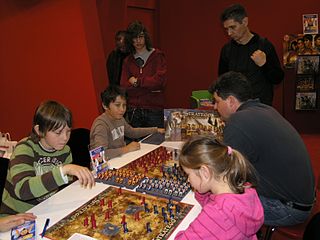
Stratego is a strategy board game for two players on a board of 10×10 squares. Each player controls 40 pieces representing individual officer and soldier ranks in an army. The pieces have Napoleonic insignia. The objective of the game is to either find and capture the opponent's Flag or to capture so many enemy pieces that the opponent cannot make any further moves. Stratego has simple enough rules for young children to play but a depth of strategy that is also appealing to adults.

Xiangqi, commonly known as Chinese chess or elephant chess, is a strategy board game for two players. It is the most popular board game in China. Xiangqi is in the same family of games as shogi, janggi, Western chess, chaturanga, and Indian chess. Besides China and areas with significant ethnic Chinese communities, this game is also a popular pastime in Vietnam, where it is known as cờ tướng, literally 'General's chess'.
Baroque chess is a chess variant invented in 1962 by Robert Abbott. In 1963, at the suggestion of his publisher, he changed the name to Ultima, by which name it is also known. Abbott later considered his invention flawed and suggested amendments to the rules, but these suggestions have been substantially ignored by the gaming community, which continues to play by the 1962 rules. Since the rules for Baroque were first laid down in 1962, some regional variation has arisen, causing the game to diverge from Ultima.

Checkers, also known as draughts, is a group of strategy board games for two players which involve forward movements of uniform game pieces and mandatory captures by jumping over opponent pieces. Checkers is developed from alquerque. The term "checkers" derives from the checkered board which the game is played on, whereas "draughts" derives from the verb "to draw" or "to move".
Capablanca chess is a chess variant invented in the 1920s by World Chess Champion José Raúl Capablanca. It incorporates two new pieces and is played on a 10×8 board. Capablanca believed that chess would be played out in a few decades. This threat of "draw death" for chess was his main motivation for creating a more complex version of the game.
Martian Chess is an abstract strategy game for two or four players invented by Andrew Looney in 1999. It is played with Icehouse pyramids on a chessboard. To play with a number of players other than two or four, a non-Euclidean surface can be tiled to produce a board of the required size, allowing up to six players.
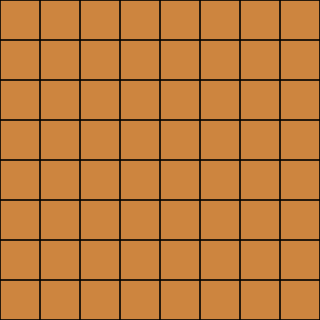
Makruk, or Thai chess, is a strategy board game that is descended from the 6th-century Indian game of chaturanga or a close relative thereof, and is therefore related to chess. It is part of the family of chess variants.
Tamerlane chess is a medieval chess variant. Like modern chess, it is derived from shatranj. It was developed in Central Asia during the reign of Emperor Timur, and its invention is also attributed to him. Because Tamerlane chess is a larger variant of chaturanga, it is also called Shatranj Al-Kabir, as opposed to Shatranj as-saghir. Although the game is similar to modern chess, it is distinctive in that there are varieties of pawn, each of which promotes in its own way.
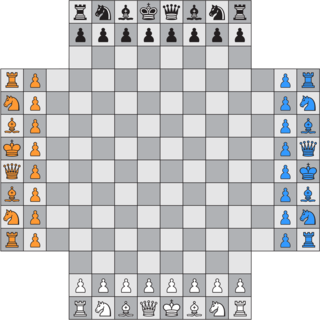
Four-player chess is a family of chess variants played with four people. The game features a special board typically made of a standard 8×8 square, with 3 rows of 8 cells each extending from each side, and requires two sets of differently colored pieces. The rules are similar to, but not the same as, regular chess. There are a variety of different rule variations; most variations, however, share a somewhat similar board and piece setup.
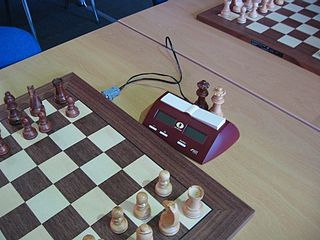
In chess, promotion is the replacement of a pawn with a new piece when the pawn is moved to its last rank. The player replaces the pawn immediately with a queen, rook, bishop, or knight of the same color. The new piece does not have to be a previously captured piece. Promotion is mandatory when moving to the last rank; the pawn cannot remain as a pawn.

Chu shogi is a strategy board game native to Japan. It is similar to modern shogi in its rules and gameplay. Its name means "mid-sized shogi", from a time when there were three sizes of shogi variants that were regularly being played. Chu shogi seems to have been developed in the early 14th century as a derivative of dai shogi. There are earlier references, but it is not clear that they refer to the game as we now know it.
Fritz and Chesster is a series of educational programs about chess for children. In each of the four PC games, Fritz White and his cousin Bianca learn chess with the help of the anthropomorphic rat Chesster. In the first three games, they learn various elements of chess before competing against King Black in a chess game; the fourth game is set on an alien planet. The first game teaches the rules of the game, along with some basic checkmates and strategy. The next games teach opening theory, tactics, middlegame analysis and endgames, along with checkmate patterns. Other games feature chess variants, chess puzzles or timed games with highscore boards.

Hasami shogi is a variant of shogi. The game has two main variants, and all Hasami variants, unlike other shogi variants, use only one type of piece, and the winning objective is not checkmate. One main variant involves capturing all but one of the opponent's men; the other involves building an unbroken vertical or horizontal chain of five-in-a-row.
Whale Shogi is a modern variant of shogi. It is not, however, Japanese: it was invented by R. Wayne Schmittberger of the United States in 1981. The game is similar to Judkins shogi, but with more pieces, and the pieces are named after types of whale.

Circular chess is a chess variant played using the standard set of pieces on a circular board consisting of four rings, each of sixteen squares. This is topologically equivalent to playing on the curved surface of a cylinder.

Zillions of Games is a commercial general game playing system developed by Jeff Mallett and Mark Lefler in 1998. The game rules are specified with S-expressions, Zillions rule language. It was designed to handle mostly abstract strategy board games or puzzles. After parsing the rules of the game, the system's artificial intelligence can automatically play one or more players. It treats puzzles as solitaire games and its AI can be used to solve them.

The following outline is provided as an overview of and topical guide to chess:
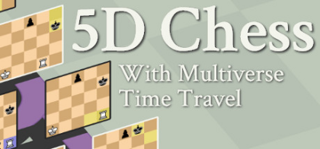
5D Chess with Multiverse Time Travel is a 2020 chess variant video game released for Microsoft Windows, macOS, and Linux by American studio Thunkspace. Its titular mechanic, multiverse time travel, allows pieces to travel through time and between timelines in a similar way to how they move through ranks and files.













